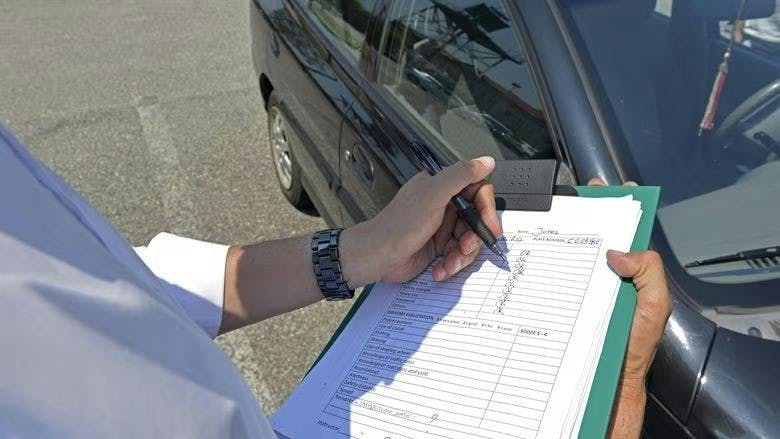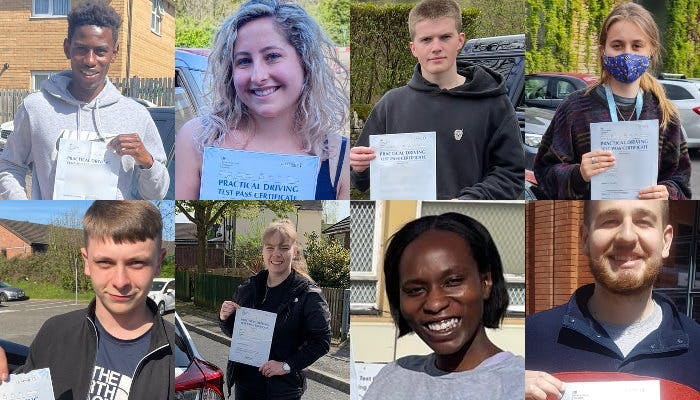The driving test is one of the most important moments in many people's lives. Over the years, plenty of myths have sprung up around it — one of the most 'popular' is that driving examiners have a pass or fail quota. It's a common excuse trotted out by those whose test doesn't go to plan — but is there any truth to it? No smoke without fire, right?
Well, let's find out. We're here to debunk driving test-related mysteries and provide learners with sweet, sweet clarity. Today we'll cover the frequently asked question: do driving examiners have quotas? We’re also going to take a look at any other factors that have an impact on the outcome of your test.
Do driving test quotas exist?

Throughout their driving journey, learner drivers have all sorts of worries about the practical test. While many of these are perfectly legitimate, some venture into the bizarre.
A significant number of learners seem to put real stock into the idea that driving examiners are handed quotas by the DVSA—telling them exactly how many learners they need to pass and fail each month. If this were indeed the case, then plenty of worthy drivers would miss out on a licence not through lack of ability, but because timing wasn't on their side. You’ve probably been told this particular myth by other learner drivers.
Of course, that’s all it really is—a myth. Examiners don’t pass or fail a learner driver because they’ve been given quotas by the DVSA. They carefully observe a learner's driving style and use a mark sheet to keep track during the test—following on from the DVSA’s strict guidelines. If you’re up to their high standard, then you pass. If you’re not, then you fail. Anyone who tells you otherwise is just looking for a reason to excuse them failing the practical. There’s absolutely nothing to suggest that driving examiners have a quota in place.
It’s just one of the many driving test myths that circulates around the learner community. Examiners have no reason to fail candidates on purpose—it would only give them further work down the line, after all!
Why is it such a popular myth?
It’s pretty simple: most of the people peddling this rumour have failed their driving test in the past. Understandably, these learners look for a reason to explain why they failed their test. Instead of addressing the fact that they must have bad driving habits, or suffered a case of test day nerves, they instead look to blame the driving examiner.
Failing the driving test can be soul crushing. Unfortunately, some learners lash out because of it—it’s why driving examiner abuse and driving test myths can be so prevalent.
I'm still worried about quotas. What should I do?

If you’re still not fully convinced that examiners aren’t going out of their way to fail you, we’ve got a few solutions for you. For starters, you might want to think about taking your driving instructor on your test.
Not only can they be a comforting presence during your practical, they can also act as a kind of witness—if the examiner really is going out of their way to fail you, then your instructor should be able to pick up on it.
If that’s not enough, why not have a peek at the driving test mark sheet? If you know what the examiner is looking out for, you’ll be better prepared.
You can also check out our top tips in the guides below to make sure your test is smooth sailing:
Now that we’ve established that examiners do not have a pass or fail quota, we can move onto the facts that can affect the outcome of your test.
Factors that can affect the outcome of your driving test
Before we get stuck into this section, we’d first like to make one thing clear. Whilst the following factors can have an effect on driving test results, you shouldn’t use them as a guide to determine how likely it is that you’ll pass your practical. It’s your hard work that will get you the outcome you want after all.
Now that’s out of the way, let’s get started!
Are you a young or old driver?
As we’ve explored in the past, age has a pretty big impact on the outcome of your driving test. That is, the younger you are, the better your chances are. We’ve found that 17-year-olds currently have the highest pass rates around. The current national average pass rate stands at 45.8%, moving up a whopping 10% for 17-year-old learner drivers.
As learners increase in age, however, pass rates slowly start to decrease. Whilst age certainly has an effect on the outcome of your driving test, it doesn’t mean that older drivers have no chance of passing—it just means they’ve got a bigger disadvantage going in for the test. There certainly isn’t a cut-off point for learning to drive.
If you put in the effort and take lessons with a professional, it will pay off.
Where are you taking your practical driving test?
One of the biggest trends you’ll likely notice with driving test pass rates by area is that learners taking their test in the countryside will have a better chance of passing than those located in a city. That's because rural areas tend to lack some of the trickier road features that are so prevalent in busy cities, such as multi-lane roundabouts, dual carriageways and so on. Even if they do have these features, learners aren’t facing heavy congestion or as many road users.
That’s not to say that rural areas don’t come with their own challenges. Learner drivers taking their test in these types of areas have to tackle narrow, winding lanes, unmarked junctions and much more.
Still, we’d like to remind you how important it is that you take your test in your local area.You’ll be taking to these roads unsupervised once you’ve passed your test, so you need to be familiar with them. Otherwise, you could find yourself completely stumped when facing certain road features and types in your local area.
Have you taken a break from driving?
Plenty of learner drivers end up having to take a long break from learning to drive. Sometimes it’s due to a bad experience with an instructor and other times it’s because they simply don’t have enough money at the time to continue.
If you’re coming back to driving after a long break, it can be difficult adjusting to being back behind the wheel. Even if you’ve had 20+ hours of experience, you’ll probably have forgotten half of what you covered previously. Instead of diving headfirst into a driving test, you should take the time to make sure your driving skills are actually up to snuff. The best way to do this is to take some extra lessons with a DVSA-approved instructor.
Not sure how many lessons you’ll need to get back up to test standard? Answer a few simple questions and our course recommender will help you determine how many hours you need before you’re test-ready.
Are you taking lessons with a DVSA-approved instructor?

As easy—and cheap—as it can be to get your best friend or parent to teach you how to drive, it’s not going to give you the best chance of passing your test.
If you want to impress the driving examiner, then you need to drive to the high standard they expect. Even if your friend or family member is a great driver, they’ll undoubtedly have a couple of bad driving habits up their sleeves. The best way to make sure you become a safe and confident driver is to take lessons with a DVSA-approved instructor.
Already taking lessons with a driving instructor? Worried they’re not on the official register? Read our guide to find out how you can check if your instructor is DVSA-approved.
Are you taking hourly driving lessons or an intensive course?
You might not think it, but even the pace and intensity of your driving lessons can affect the outcome of your test. If you’re only doing one lesson a week, for example, you might find that it’s taken you a lot longer to adjust to picking up certain driving skills, e.g., clutch control. It can take a while to build up muscle memory, especially if you’re driving infrequently.
Intensive and semi-intensive driving courses, by comparison, often tend to produce better results with a learner’s development. With longer lessons and smaller breaks between, learners can build up their skills and get up to test standard in far less time than those taking hourly lessons every week.
Have you sorted out your bad driving habits?
As we’ve already touched upon briefly, many of the learners who peddle the quota myth have been unsuccessful with the driving test—sometimes on numerous occasions. Of course, in most cases, these learners are failing because they haven’t actually taken the time to iron out their bad driving habits.
Essentially, they fail their test and then go back in for another one without actually addressing why they failed in the first place. If you’ve failed your test recently, you should take the time to improve your driving and make sure you’re driving at the high standard expected by the DVSA.
The best way to make sure you don’t make the same driving test faults the next time around is to take a refresher course. Working with a local ADI, you can get rid of your bad habits, regain your confidence and pass your test with flying colours!
Are you practicing outside of driving lessons?
Learners who take the time to practice their driving outside of lessons with their friends or family stand a much better chance of passing their driving test than those that don’t.
While professional tuition is, of course, vital to your learning, extra practise is also important. It gives learners more time to reinforce their skills and also get to grips with driving in the local area. Essentially, the more experience you get under your belt, the more comfortable and prepared you’ll be for your practical test.
Before you start practicing, however, you should first make sure that you’re being supervised within the law. When driving, you need to be accompanied by a fully qualified driver over the age of 21 who has held their licence for at least three years. They must also hold a licence for the car transmission you’re driving. You can get a better look at this in our guide covering who can sit with a learner driver.
Note: While learner drivers may now legally drive on motorways, they must be accompanied by an approved driving instructor while doing so. A friend or family member may not supervise motorway driving.
Are you actually ready to take your test?

Though it might seem rather obvious to point out, if you’re not actually ready to take your driving test then you’re probably not going to pass.
Many learners start to feel immense pressure to pass as soon as possible once they start learning to drive. Some cut their lessons short and even go in for a test before their instructor says they should. Whilst we understand the eagerness of it all, it will only serve to undermine you during the practical. In short, you should only take the driving test when you’re ready.
Of course, there is a difference between being ready and feeling ready. Plenty of learners are prepared and have the skills to pass the test, only to end up suffering from test day nerves. It’s completely normal to not feel like you’re ready. In most cases, the same learners who panic about their test are the ones who absolutely smash it. Remember, your instructor wouldn’t urge you to take the test if they didn’t think you were ready.
As you can see, there are plenty of factors that can have an impact on the outcome of your driving test—none of which include pass or fail quotas.
Of course, you shouldn’t use these factors to determine how likely it is that you’ll pass. It’s your driving ability that will get you your full licence, after all.
Driving Test Quota: FAQs
1. I think my driving examiner failed me on purpose. What should I do?
If you feel like your driving examiner treated you unfairly, you can appeal your driving test. Before you do this, make sure you’re doing this for the right reasons. You shouldn’t be doing it just because you’re angry you failed. Additionally, you should be aware that appealing your driving test will not overturn the result.
Instead, if you’re successful, you’ll get a free test. Worried about getting the same examiner for your retest? Check out our post on whether or not you can refuse a driving test examiner.
2. What happens if I fail my driving test?
To put it simply, if you fail, you try again. You’ll get a feedback sheet at the end of your test, so if you do fail, you know exactly which areas you need to work on before you go in for another. Once you’ve brushed up on your driving, you can go in for another test. Please be aware that you have to wait 10 working days before you can take a new one.
3. How many times can I take the driving test?
As many times as you need! Yep—there’s no limit in place. Other than the 10 working day wait, there are no other limitations in place. Of course, if you’re reaching test number 3 or more, you should think about taking additional lessons with a professional—just to make sure you’re up to test standard.
4. Will I fail my test if I stall the car?
It depends. If you stall your car, only to react quickly by restarting it and paying close attention to the roads around you, you should only get a minor fault. If, on the other hand, you panic and forget to survey the roads around you before moving off, you’ll probably end up with a serious fault. The examiner might even decide to stop the driving test early.
5. Should I talk to my examiner?
If you’d like! It’s entirely up to you. If you’re a social butterfly who doesn’t find talking in the car whilst driving distracting, then go right ahead. If, however, you’re someone who can’t concentrate on conversing and driving at the same time, then feel free to drive in silence. Trust us, the examiner won’t take it personally.
6. What will happen on my driving test?
Before you start driving, you’ll complete an eyesight test and answer a ‘tell me’ question from the ‘show me, tell me’ section. Then, you’ll be taken on a test route that will include general driving, independent driving and one driving test manoeuvre. You’ll also have to answer a ‘show me’ question whilst driving. You can get a more in-depth look at this in our guide to what happens in a driving test.
7. Can my instructor sit in on my driving test?
Yep! Plenty of learner drivers opt to take their instructor on the test with them. It can put your nerves at ease and also help you if you do end up failing—your instructor can pay attention to your feedback and figure out what you need to do before you take the test again. Of course, if you feel like having your instructor in the backseat will have you freezing up, ask them to stay behind at the test centre.
8. How many minors can I get without failing?
You can receive up to 15 minor faults and still pass your driving test. If you accumulate more than that, or pick up a single serious fault, then that’s it—you fail your driving test. We would like to advise you to continue on in your test, even if you feel like you’ve failed halfway through, just because you don't always know what the outcome will be.
Subscribe for driving advice, offers & more
We'd love to let you know about our courses, news and offers via email. You may unsubscribe at any time.
Star Genie Limited trading as PassMeFast. Company number 10093359
Copyright © 2024 owned by Star Genie Limited
PassMeFast, Blue Tower, MediaCityUK, Salford, M50 2ST
